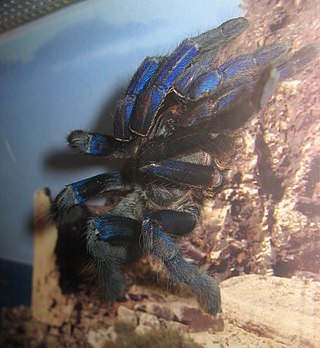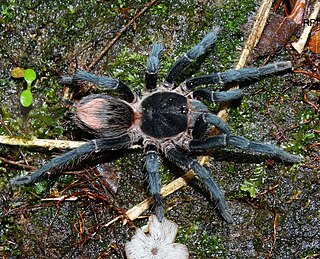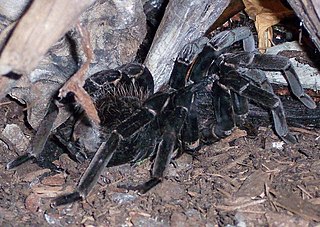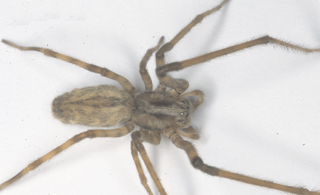
Ornithoctoninae is a subfamily of tarantulas found in Southeast Asia. It was first erected in 1895 by Reginald Innes Pocock based on the type specimen Ornithoctonus andersoni.

Theraphosa is a genus of South American tarantulas that was first described by Charles Athanase Walckenaer in 1805. The Theraphosa spiders are some of the largest known to science. As of May 2020 it contains three species, found in Guyana, Brazil, Venezuela, and Colombia. They stridulate by rubbing setae on their pedipalps and legs.

Selenocosmia is a genus of tarantulas that was first described by Anton Ausserer in 1871. The genus is found in China, New Guinea, Indonesia, Australia, Indonesia, Myanmar, Malaysia, Laos, Vietnam, Philippines, India and Pakistan. They are commonly referred to as whistling or barking spiders, due to their ability to stridulate using lyra hairs.

Macrothele is a genus of mygalomorph spiders in the family Macrothelidae, and was first described by A. Ausserer in 1871. Most species occur in Asia, from India to Japan, and Java, with five found in Africa, and two in Europe. The name is derived from Ancient Greek μακρός ("makro-"), meaning "big", and θηλή ("thele"), referring to the spinnerets.

Psalmopoeus is a genus of the family Theraphosidae containing various species of tarantulas. The genus is native to Trinidad and Tobago, Colombia, Ecuador, Venezuela, Guyana, Brazil, Belize, Panama, Nicaragua, Costa Rica, Mexico, Guatemala and Honduras. All of these tarantulas are arboreal in nature, Psalmopoeus victori being the first arboreal tarantula of Mexico.

Tarantulas comprise a group of large and often hairy spiders of the family Theraphosidae. As of August 2022, 1,040 species have been identified, with 156 genera. The term "tarantula" is usually used to describe members of the family Theraphosidae, although many other members of the same infraorder (Mygalomorphae) are commonly referred to as "tarantulas" or "false tarantulas". Some of the more common species have become popular in the exotic pet trade. Many New World species kept as pets have setae known as urticating hairs that can cause irritation to the skin, and in extreme cases, cause damage to the eyes.

Tapinauchenius is a genus of tarantulas that was first described by Anton Ausserer in 1871. The name is a combination of the Greek ταπεινός, meaning "low", and αὐχήν, meaning "neck". In 2022, the genus Pseudoclamoris was transferred to Tapinauchenius.

The Malaysian earthtiger tarantula, scientific name Omothymus schioedtei, is a species of spider in the family Theraphosidae (tarantulas), found in Peninsular Malaysia. It is also known by the synonym Cyriopagopus schioedtei.

Cyriopagopus is a genus of southeast Asian tarantulas found from Myanmar to the Philippines. As of March 2017, the genus includes species formerly placed in Haplopelma. It was first described by Eugène Louis Simon in 1887.

Phlogiellus is a genus of tarantulas that was first described by Reginald Innes Pocock in 1897. They are found throughout Asia and Papua New Guinea, including Indonesia, the Philippines, Papua New Guinea, China, Myanmar, Malaysia, Borneo, Thailand, the Solomon Islands and Taiwan. Phlogiellus is part Latin and part Greek, the first part being "φλóξ φλoγóϛ", meaning flame, the second part being "ellus" which is a latin diminutive suffix.

Homoeomma is a genus of South American tarantulas that was first described by Anton Ausserer in 1871. It is considered a senior synonym of Calopelma, Butantania, and of Cyclothoracoides. These tarantulas are usually quite small and usually burrow a few centimeters under a rock or log.

Lampropelma is a genus of Indonesian tarantulas that was first described by Eugène Louis Simon in 1892. As of March 2020 it contains two species, found in Indonesia.
Phormingochilus is a genus of Indonesian tarantulas that was first described by Reginald Innes Pocock in 1895. They are occasionally kept as exotic pets, and are known for moving in bursts of speed and being defensive when cornered.

Xenesthis is a genus of tarantulas that was first described by Eugène Louis Simon in 1891. As of May 2020 it contains four species, found in Colombia and Venezuela, though it was previously considered to be found in Panama.
Rhitymna is a genus of huntsman spiders described in 1897 by Eugène Simon. Members of this genus can be distinguished by a number of characteristics, but it is most often confused with Olios species, many of which also have the Y-shaped pattern on the dorsal opisthosoma.

Fecenia is a genus of cribellate araneomorph spiders in the family Psechridae, and was first described by Eugène Louis Simon in 1887.
Melognathus is a monotypic genus of southeast Asian tarantulas containing the single species, Melognathus dromeus. It was erected in 1917 for a holotype collected from a ship that visited southeast Asia. In 1985, the species was moved to Cyriopagopus because the autapomorphies were not considered significant enough to warrant a new genus. Opinions between biologists were split, some using the original name and some using Cyriopagopus. In a 2019 report, Gabriel and Sherwood pointed out that in addition to the differences in pedipalp morphology, the holotype exhibits leg features that indicate an arboreal species, while species of Cyriopagopus are largely terrestrial. The ambiguous location of the holotype has left room for speculation, but as of February 2022 the World Spider Catalog accepts this genus.
Birupes is a monotypic genus of southeast Asian tarantulas containing the single species, Birupes simoroxigorum. It was first described by R. Gabriel and D. Sherwood in 2019, and it has only been found in Malaysia.

The Selenocosmiinae are a subfamily of tarantulas found throughout South-East Asia and Australia. This subfamily is defined by the presence of a lyra on the maxillae and strikers on the chelicerae, allowing these spiders to stridulate and produce a "hissing" sound. However some species within Phlogiellus may have secondary lost their lyra but retain their strikers. The monophyly of the subfamily has been only tested using genetic data with a handful of genera or species in a few studies. However, these studies found genera that had been previously placed in this subfamily were actual their own separate subfamily (Poecilotheria) and that Selenocosmiinae is most closely related to the Indian Thrigmopoeinae. As of 2021, Selenocosmiinae contains 11 genera.
Murphyarachne is a monotypic genus of Peruvian tarantulas, with one species, Murphyarachne ymasumacae. It was first described by Sherwood and Gabriel in 2022. The genus is named after Frances Mary Murphy and John Alan Murphy for their contributions to arachnology, and the Greek term "arachne", which is the word for spider.















